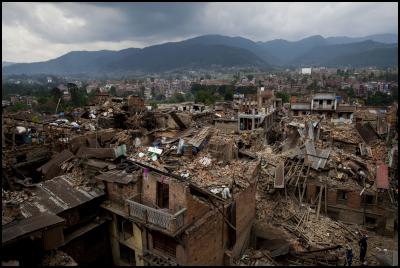Trying to make sense of it all
Trying to make sense of it all
Kyle Degraw is the Humanitarian Communications Manager for Save the Children. This is his personal account of his days in Nepal just after the April 25 earthquake.
I’ve just landed in London from an overnight flight from Kathmandu. Minutes ago another massive earthquake has hit Nepal.
And only hours ago, as I sat in the departures lounge of the Kathmandu airport, with rainwater from a thunderstorm streaming through the ceiling and ever watchful for news of yet another closure due to cracks in the runway, I struggle to find the words to describe the effects of the first earthquake.

It’s a tangle of paradoxes. Just yesterday I was observing Tibetan monks circle the beautiful (and intact) Boudanath Stupa, turning its hundreds of prayer wheels as they pass by, and suddenly the morning silence broken by US military helicopters heading towards the mountains in Gorkha and Sindhupalchowk, the worst affected areas. WFP helicopters quickly follow suit. The few tourists left in the square seemed not to notice.
This earthquake did not strike in the usual manner. Instead of destruction rippling out from the epicentre in concentric circles, it stretched straight out in a line to some of the most remote villages in the country, from Gorkha to Sindhupalchowk. This has spared Kathmandu the worst, though the effects are nonetheless devastating. Cultural heritage destroyed, critical supply routes bottlenecked, and much loss of life and livelihoods. And yet, while some buildings are reduced to heaps of rubble and many are damaged, most others are entirely untouched. A roll of the dice.
A game of chance indeed: I Iisten to news about this new 7.4 earthquake striking Sindupalchowk, where I visited a temporary learning centre and household kit distribution only two days ago. Frenzied emailing and tweeting followed suit. At the immigration counter, I broke the news to the border agent, a man of Indian origin who was taken aback at the news. Just on Sunday, I spoke with one community elder, Bharat, who said his biggest fear “is another earthquake, undoing the progress we’re making and hurting our community even more”. It seems his worst fears have come true. Bharat-ji is in my thoughts today, and all those already reeling from the April 25 quake.
The scene in his and other remote villages is not nuanced, as it is in Kathmandu. Entire villages, flattened, punctuate the serenity and beauty of the Himalayan foothills. I struggle to comprehend exactly how anyone survived this earthquake in these regions, let alone entire communities. Most families that I spoke to were thankful for the earthquake’s timing, as if it were a friendly gesture: at mid day on the weekend, most were outdoors and away from danger. And yet the physical destruction is total: entire villages razed, livestock lost, and road access blocked by landslides. Today’s earthquake provided a similar friendly gesture of timing by Mother Nature.
Accessing the hardest to reach has been and will continue to be the major challenge in this response. Last week, in dry and clear conditions, it took me no less than 8 hours by road to reach Arupokhari, in Gorkha. The final 4 hours of that journey covered maybe 20 kilometres. Add the coming monsoon rains and seasonal landslides into the mix, and we’re facing a race against time to reach the hardest to reach.
Plans are afoot to share helicopter space with other agencies and load up donkeys with essential supplies for survival in areas without road access. To date, the team has been phenomenal – over 79,000 people reached in the first two weeks, with numbers continuing to rise. Literally, we are doing whatever it takes.
Because of the challenges presented by the odd pattern of destruction, the terrain, the coming weather troubles and resulting upswing in disease, it is clear the Nepal is a different kind of earthquake from those in recent memory. It is no Haiti, China, or Pakistan. A damaged Kathmandu grinds on, restaurants and shops are open, and a handful of curious tourists linger. The team on the ground is adapting well, and I have full confidence in Nepal building back better.
ENDS


 Carbon Market Watch: Going For Green - Is The Paris Olympics Winning The Race Against The Climate Clock?
Carbon Market Watch: Going For Green - Is The Paris Olympics Winning The Race Against The Climate Clock? New Zealand Defence Force: NZDF Working With Pacific Neighbours To Support Solomon Islands Election
New Zealand Defence Force: NZDF Working With Pacific Neighbours To Support Solomon Islands Election UN News: Ceasefire The Only Way To End Killing And Injuring Of Children In Gaza
UN News: Ceasefire The Only Way To End Killing And Injuring Of Children In Gaza ICHRP: US-Japan-Philippines Trilateral Summit Makes The Philippines A Battlefield For US-China Conflict
ICHRP: US-Japan-Philippines Trilateral Summit Makes The Philippines A Battlefield For US-China Conflict East West Center: Environmental Journalist Alexander Kaufman Receives East-West Center’s Inaugural Melvin M.S. Goo Writing Fellowship
East West Center: Environmental Journalist Alexander Kaufman Receives East-West Center’s Inaugural Melvin M.S. Goo Writing Fellowship Compassion in World Farming: Octopus Farm Must Be Stopped, Say Campaigners
Compassion in World Farming: Octopus Farm Must Be Stopped, Say Campaigners